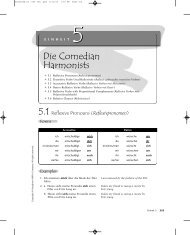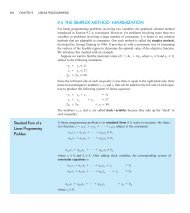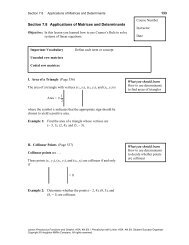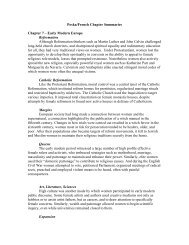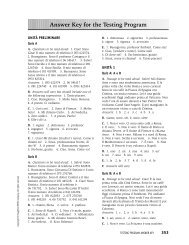9.3 THE SIMPLEX METHOD: MAXIMIZATION
9.3 THE SIMPLEX METHOD: MAXIMIZATION
9.3 THE SIMPLEX METHOD: MAXIMIZATION
Create successful ePaper yourself
Turn your PDF publications into a flip-book with our unique Google optimized e-Paper software.
500 CHAPTER 9 LINEAR PROGRAMMING<br />
The Simplex Method<br />
(Standard Form)<br />
To solve a linear programming problem in standard form, use the following steps.<br />
1. Convert each inequality in the set of constraints to an equation by adding slack<br />
variables.<br />
2. Create the initial simplex tableau.<br />
3. Locate the most negative entry in the bottom row. The column for this entry is called<br />
the entering column. (If ties occur, any of the tied entries can be used to determine<br />
the entering column.)<br />
4. Form the ratios of the entries in the “b-column” with their corresponding positive<br />
entries in the entering column. The departing row corresponds to the smallest non-<br />
negative ratio biaij .<br />
(If all entries in the entering column are 0 or negative, then there<br />
is no maximum solution. For ties, choose either entry.) The entry in the departing row<br />
and the entering column is called the pivot.<br />
5. Use elementary row operations so that the pivot is 1, and all other entries in the<br />
entering column are 0. This process is called pivoting.<br />
6. If all entries in the bottom row are zero or positive, this is the final tableau. If not, go<br />
back to Step 3.<br />
7. If you obtain a final tableau, then the linear programming problem has a maximum<br />
solution, which is given by the entry in the lower-right corner of the tableau.<br />
Note that the basic feasible solution of an initial simplex tableau is<br />
x 1 , x 2 , . . . , x n , s 1 , s 2 , . . . , s m 0, 0, . . . , 0, b 1 , b 2 , . . . , b m .<br />
This solution is basic because at most m variables are nonzero (namely the slack variables).<br />
It is feasible because each variable is nonnegative.<br />
In the next two examples, we illustrate the use of the simplex method to solve a<br />
problem involving three decision variables.<br />
EXAMPLE 2 The Simplex Method with Three Decision Variables<br />
Use the simplex method to find the maximum value of<br />
z 2x1 x2 2x3 Objective function<br />
subject to the constraints<br />
2x 1 2x 2 2x 3 10<br />
2x 1 2x 2 2x 3 20<br />
2x 1 2x 2 2x 3 25<br />
where x1 0, x2 0, and x3 0.<br />
Solution Using the basic feasible solution<br />
x 1 , x 2 , x 3 , s 1 , s 2 , s 3 0, 0, 0, 10, 20, 5<br />
the initial simplex tableau for this problem is as follows. (Try checking these computations,<br />
and note the “tie” that occurs when choosing the first entering variable.)







